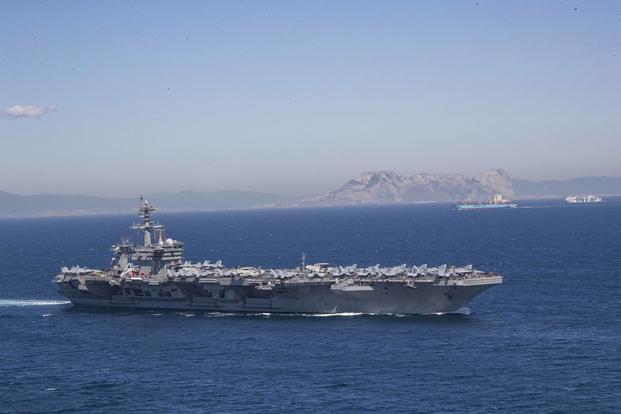The Navy's quick response to "troubling and escalatory" warnings from Iran shows a new deployment model meant to keep adversaries guessing is working, the service's top admiral said Monday.
The Abraham Lincoln Strike Group was conducting training exercises in Europe during a planned deployment when it was ordered to pivot toward the Middle East, Chief of Naval Operations Adm. John Richardson said at the annual Sea-Air-Space conference outside Washington.
"I find it very encouraging that while the Abraham Lincoln Strike Group was out exercising in the European theater ... and national leadership requires, requests or orders that force package to go to a different theater, it's just a matter of … very fluidly and dynamically getting all of that power to move to that theater," he said.
The model, called dynamic force employment, was introduced in last year's National Defense Strategy. It calls for less predictable maneuvering and posturing "to shape proactively the strategic environment," the strategy states.
Moving the strike group out of the Mediterranean Sea and toward the Middle East came in response to "a number of troubling and escalatory indications and warnings" from Iran, John Bolton, the White House national security adviser, said in a statement. An official told The Associated Press on Sunday that U.S. troops at sea and on land were believed to be the potential targets.
"The United States is deploying the USS Abraham Lincoln Carrier Strike Group and a bomber task force to the U.S. Central Command region to send a clear and unmistakable message to the Iranian regime that any attack on United States interests or on those of our allies will be met with unrelenting force," Bolton wrote.
The sea services in particular are well-suited for quick response, Richardson said. Strike groups, amphibious ready groups and Coast Guard cutters are "maneuver forces by design."
"They're designed to move around the globe very fluidly in response to changing security situations," he said.
This isn't the first time the Navy has used the dynamic force employment model. Last year, the Harry S. Truman Strike Group returned to its homeport in Virginia about five weeks after it deployed -- a big change from traditional seven-month deployments. It later deployed again after about three months at home.
-- Gina Harkins can be reached at gina.harkins@military.com. Follow her on Twitter @ginaaharkins.













